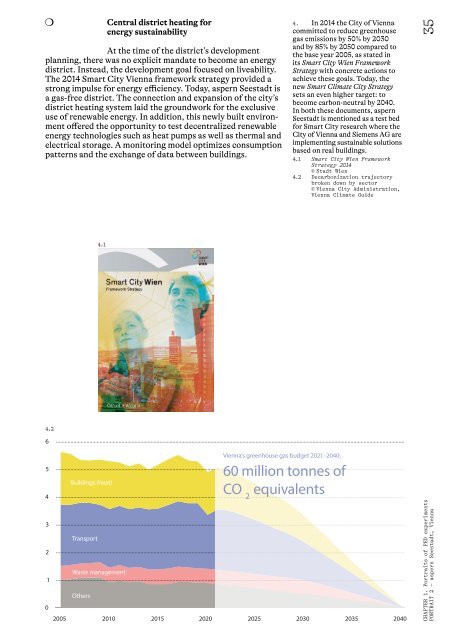Powering the energy transition at the district level_Cities4PEDs_AWB_final
You also want an ePaper? Increase the reach of your titles
YUMPU automatically turns print PDFs into web optimized ePapers that Google loves.
Central <strong>district</strong> he<strong>at</strong>ing for<br />
<strong>energy</strong> sustainability<br />
At <strong>the</strong> time of <strong>the</strong> <strong>district</strong>’s development<br />
planning, <strong>the</strong>re was no explicit mand<strong>at</strong>e to become an <strong>energy</strong><br />
<strong>district</strong>. Instead, <strong>the</strong> development goal focused on liveability.<br />
The 2014 Smart City Vienna framework str<strong>at</strong>egy provided a<br />
strong impulse for <strong>energy</strong> efficiency. Today, aspern Seestadt is<br />
a gas-free <strong>district</strong>. The connection and expansion of <strong>the</strong> city’s<br />
<strong>district</strong> he<strong>at</strong>ing system laid <strong>the</strong> groundwork for <strong>the</strong> exclusive<br />
use of renewable <strong>energy</strong>. In addition, this newly built environment<br />
offered <strong>the</strong> opportunity to test decentralized renewable<br />
<strong>energy</strong> technologies such as he<strong>at</strong> pumps as well as <strong>the</strong>rmal and<br />
electrical storage. A monitoring model optimizes consumption<br />
p<strong>at</strong>terns and <strong>the</strong> exchange of d<strong>at</strong>a between buildings.<br />
4. In 2014 <strong>the</strong> City of Vienna<br />
committed to reduce greenhouse<br />
gas emissions by 50% by 2030<br />
and by 85% by 2050 compared to<br />
<strong>the</strong> base year 2005, as st<strong>at</strong>ed in<br />
its Smart City Wien Framework<br />
Str<strong>at</strong>egy with concrete actions to<br />
achieve <strong>the</strong>se goals. Today, <strong>the</strong><br />
new Smart Clim<strong>at</strong>e City Str<strong>at</strong>egy<br />
sets an even higher target: to<br />
become carbon-neutral by 2040.<br />
In both <strong>the</strong>se documents, aspern<br />
Seestadt is mentioned as a test bed<br />
for Smart City research where <strong>the</strong><br />
City of Vienna and Siemens AG are<br />
implementing sustainable solutions<br />
based on real buildings.<br />
4.1 Smart City Wien Framework<br />
Str<strong>at</strong>egy 2014<br />
© Stadt Wien<br />
4.2 Decarboniz<strong>at</strong>ion trajectory<br />
broken down by sector<br />
© Vienna City Administr<strong>at</strong>ion,<br />
Vienna Clim<strong>at</strong>e Guide<br />
35<br />
4.1<br />
P<strong>at</strong>hway of Vienna’s greenhouse gas emissions to <strong>the</strong> 2040 target<br />
4.2<br />
Greenhouse gas emissions in million tonnes of CO equivalents<br />
2<br />
6<br />
5<br />
4<br />
3<br />
2<br />
1<br />
0<br />
Buildings (he<strong>at</strong>)<br />
Transport<br />
Waste management<br />
O<strong>the</strong>rs<br />
Vienna’s greenhouse gas budget 2021–2040:<br />
60 million tonnes of<br />
CO 2<br />
equivalents<br />
2005 2010 2015 2020 2025 2030 2035 2040<br />
CHAPTER 1. Portraits of PED experiments<br />
PORTRAIT 2 – aspern Seestadt, Vienna

















